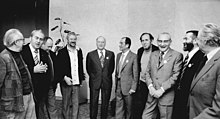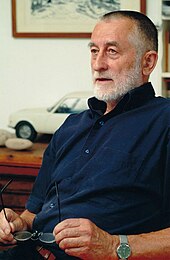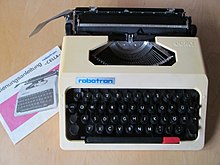Karl Clauss Dietel
Karl Clauss Dietel (born October 10, 1934 in Reinholdshain near Glauchau ; † January 2, 2022 in Chemnitz ) was a German form and product designer . Among other things, he designed in the GDR. Vehicles, radios, EDP systems, typewriters and knitting machines. Dietel was a professor at the Technical School for Applied Arts in Schneeberg , its director from 1986 to 1990, and from 1988 to 1990 president of the Association of Visual Artists of the GDR .
Life
Karl Clauss Dietel completed an apprenticeship as a machine fitter in Glauchau from 1949 to 1952 . He studied from 1953 to 1956 at the engineering school for motor vehicle construction in Zwickau and from 1956 to 1961 at the University of Fine and Applied Arts in Berlin-Weißensee. He then worked as a designer at VEB Central Development and Construction for Vehicle Construction (ZEK) Karl-Marx-Stadt until 1963 . In his diploma thesis he gave the vehicles of the GDR a negative judgment from a design point of view. Most of them did not deserve the title “designed” or should be assessed as “not designed”. Based on his diploma thesis for a car with the first round vehicle front and aerodynamically optimal full tail , he designed the basic design for the Wartburg 353 for the Eisenach automobile plant (AWE) in 1962 . He designed the interior design together with Lutz Rudolph .
From 1963 he worked as a freelance designer. In the period up to 1984 Dietel worked on the design of a total of seven successor models to the Trabant car , from around 1965 together with Lutz Rudolph. Four of these vehicles were completely developed ( 1: 1 models , wind tunnel , test drives with sample vehicles, etc.) and were practically about to go into series production, but were not implemented.

From 1967 to 1975 he taught on a fee basis at the College for Industrial Design in Halle, Burg Giebichenstein , and then at the Technical School for Applied Arts in Schneeberg . There he was appointed professor in 1984 , from 1986 to 1990 he was director of the technical school. After German reunification, he was confirmed as a professor in 1992.
In 1962 he became a candidate, from 1965 he was a member of the Association of Visual Artists of Germany (VBKD), later VBK / GDR. From 1970 to 1974 he was chairman of the design / arts and crafts section of the association. From the position of one of the vice-presidents of the VBK, which he had held since 1974, he resigned on June 25, 1981 in protest against the reprisals of the Office for Industrial Design AIF of the GDR. After the resignation of long-time President Willi Sitte , Dietel was elected President of the VBK in 1988, which he headed during the fall of the Berlin Wall until its dissolution in the course of reunification in 1990.
Clauss Dietel was a member of the SED and a member of the district leadership of the SED in Karl-Marx-Stadt.
He has been under observation by the MfS since 1959 , among other things in connection with the artist group Clara Mosch in Karl-Marx-Stadt. After resigning as VBK Vice President in 1981, it became an " operational process " for the MfS / GDR.
Dietel's defined design principles received particular attention. Among other things, the open principle should be named here, which enables designs that offer access for replacement, maintenance and repair. In the end, not only technical innovations can be adapted to the property, but also the changing demands and preferences of the users. This principle was clearly implemented on the Simson S 50 and S 51 mopeds .
After the end of the GDR, Dietel continued to work as a freelance designer, including for the Diamant Fahrradwerke in Chemnitz and for specialized small and medium-sized companies in Saxony. He also created architecture-related art, e.g. B. at the Mercure-Hotel Chemnitz . Together with Lutz Rudolph, he won first prize in the architecture competition Stadtpavillon Chemnitz in 1996. He also designed buildings for Volkswagen in Bratislava and Saxony .
As the first East German designer Clauss Dietel received the from the Sept. 25, 2014 Federal Economics Ministry official as the highest German award in the design conferred Federal Design Award for Lifetime Achievement. According to the jury, Dietel had a decisive influence on East German design development up to the turn of the millennium.
Quotes, concepts, terms
- Open Principle, 1967
- On power and culture in old Saxony: “Chemnitz worked to survive; from the sale of what had been developed, it was possible to live in leipzig and the whole thing was lived in dresden ”. Speaking in 1976, published in 1977 in the magazine Bildende Kunst / DDR
- Usage patina, 1971/72, first published in form + Zweck
- “The big 5 L” (long-lasting, light, Lütt, life-friendly, quiet), 1981
- Hand and serial - unique and series, 1983
- Poetry of the Functional, 2000
factories
layout
- Sports car study / model 1: 5, engineering school Kfz.-Bau Zwickau, 1955
- Car models, diploma thesis, University of Fine and Applied Arts, Berlin, 1960/61
- Radio “ Heliradio ”, KC Dietel and L. Rudolph , 1960–1991
- Front design of the W50 truck based on the W 50 basic design by Peter Thieme
- Mokicks of the series Simson SR 4-2 KC Dietel, 1962-1967; Mokicks / Roller S 50 to SR50C ,
- Realization of the open principle, KC Dietel, L. Rudolph, 1967–1990
- Basic draft of the car AWE Wartburg 353 , 1962, interior design by KC Dietel and L. Rudolph 1963–1965
- Small Computer D4a , 1963-64; Technical University of Dresden / Nikolaus Joachim Lehmann
- Slicer MS 1; 1964; FEUMA Gastromaschinen Gössnitz / Thür.
- Passenger car Trabant successor vehicles from P 603 to P 601 / W II , Sachsenring Zwickau, no serial production, KC Dietel from 1963 and with L. Rudolph from 1965; until 1984
- Lkw 515, 1013, L60 of the IWL Ludwigsfelde , serial not manufactured, KC Dietel 1963–1974;
- Truck O 611 Robur Zittau; Bus O 611, VEB Karosseriewerke Halle, KC Dietel and L. Rudolph 1973–1976, Robur LO 3004 1993–1994
- EDP system mainframe computers R300 , R21 Robotron , KC Dietel, partly with C. Berndt, 1963–1967
- Punch card punch, 1963; Zentronik Sömmerda
- Magnetic tape storage ZMB 30, ZMB 61 Carl Zeiss Jena, KC Dietel 1963–1970
- Palletizing system, 1967, PAMA Freiberg
- Typewriter model study, 1st prize competition 1965, Typewriter Works SWD Dresden
- Typewriters Erika 50/60, Erika 110/120, SWD Dresden, 1965–1981
- Car "Representative", 1969, Sachsenring Zwickau / AWE Eisenach; with E. Heinig, L. Rudolph
- Car study 1971/72, AG Council District Karl-Marx-Stadt / Culture; with L. Rudolph
- Study of the car operating area, 1976, Kulturfond / GDR, with L. Rudolph
- SIMSON Motor M 531, 1976-78, with L. Rudolph
- Electronic typewriter PKSM, 1981, SWD Dresden
- Numerical control CNC 700, 1983–1985, Numerik Karl-Marx-Stadt
- Robotron Cella typewriter , 1983–1985; Computing electronics Zella-Mehlis
- Flat circular knitting machines (FRJ 5480 to FRJ 2000, 1982–1994, Elite-Diamant, Karl-Marx-Stadt / Chemnitz)
- Motorcycles MZ ES 250/1 , 1962 KC Dietel; MZ ETZ 125/150 , MZ ETZ 251 1986-88, KC Dietel, L. Rudolph 1981-85, MZ Zschopau
- Gastromaschinen Feuma, 1964-1992; Feuma Gössnitz
- Electric bike “Cityblitz”, 1991; Elite diamond Chemnitz
- Electric car "E-SAX", study, 1991, BHL Limbach-Oberfrohna
- Vacuum casting machine VGM 750, 1992; VG Kunststofftechnik Chemnitz
- Laser welding head, 1992/93, Thyssen Krupp Drauz Hohenstein-Ernstthal
- Waggon REX Regional Express, competition entry for DB AG, 1994; with L. Rudolph, D. v. At the end
- Laser welding system CWL, 1990, for Krupp Drauz engineering company Hohenstein-Ernstthal
- “Teampunkt” - communication counter, 1999, for Krupp Drauz Ing.-Betrieb Hohenstein-Ernstthal
- Textile machines Terrot, from 2003; Terrot knitting machines Chemnitz
- Laser machines Excimer 193-1, 2005, 3D-Micromac Chemnitz
- Multifunctional phones Swingline I, Swingline II; KC Dietel and L. Rudolph 1995-1998; Sigma Chemnitz / Philips Bautzen
- Turboweld welding system, Thyssen Krupp Ravensburg, 2007; installed in the Duisburg plant
- Hedge trimmer HQM, 2015, Mogatec Drebach
Architecture-related work
- Design program Karl-Marx-Stadt / Chemnitz 1969
- FDGB home “Am Fichtelberg” Oberwiesenthal, 1972–1975;
- "Kugelbrunnen" water feature, VZ Yorckgebiet, Karl-Marx-Stadt / Chemnitz, 1972, with R. Grütz
- Ceiling elements in the Great Hall / Palace of the Republic Berlin, 1973–74; with L. Rudolph, D. v. At the end
- Building sculpture, stainless steel, FDGB-Heim “Am Fichtelberg”, 1975
- Building sculpture in stainless steel / wood, Bergakademie Freiberg canteen, 1975, with H. Brockhage
- "Constructive Plastic" / "Division"; Brückenstrasse Chemnitz, 1976–80
- “Grove of Honor of the Socialists”, Wartburgstrasse Cemetery Chemnitz, 1976–81; with H. Brockhage, G. Kohl, H. Schumann
- "Garden of friendship K.-M.-Stadt", competition entry, 1st prize, 1976, with L. Hahn, K. Wienke, H. Stephan
- Water feature in the Stadtbad Chemnitz, 1978–80
- Opera Karl-Marx-Stadt / Chemnitz - basic concept reconstruction with P. Koch; later with KH Barth, G. Hauptmann, J. Krüger 1984–1992;
- Farbbügel Schmidtbank-Passage Chemnitz, with L. Rudolph, 1999;
- Mercure Hotel Chemnitz 1996–1998; Wall of water, light guides "heavenly ladder"
- FDGB-Heim Schöneck 1978–1984;
- Water feature, Stadtbad Chemnitz 1981–1982;
- Room of Silence, Bethanien-Kliniken Chemnitz 2003, with Steffen Volmer
- House sign for Stefan Heym , Chemnitz - on the house where he was born and where he lived; Stainless steel; 2003, 2007
- Contribution to the competition “Rathausplatz Oelsnitz / Erzgebirge”, 2007; with K.-L. basement, cellar
- Restaurant SCHALOM, Chemnitz - design concept material, light, color, entrance roofing stainless steel 2010-2012
- Color concept / visual communication for the MESSE CHEMNITZ 2017 towers
- Color concept cinema "Metropol" Chemnitz 2021
Free work
- Sculpture "For Peter Mitterhofer", 1979
- Plastic "The old new"; Edelstahl / Holz, 1981, with H. Brockhage
- "Change" sculpture in front of the Chemnitz Industrial Museum, 2007–2013
- Sculpture "Teilung" Brückenstraße Chemnitz 1976 – '81
Work environment design
- Harlass foundry Wittgensdorf 1974–1984; Head of the conception group
- Krupp Drauz Hohenstein-Ernstthal 1991–1997
- Porsche AG Stuttgart 1994–1998 with L. Rudolph
- VW Slovakia Bratislava 1992–2001, VW Sachsen / Mosel 1999–2000, VW Hannover 1998–2001 with L. Rudolph
- Scherdel Marienberg from 2008, including
Signets, product graphics
- from 1960, including HELIRADIO (with L. Rudolph); SIMSON, DIAMANT, FEUMA, IFA WTZ Hohenstein-E., Theater Zwickau-Plauen, M. Brandt - Gesellschaft Chemnitz, NUMERIK, BASEG, Automotive Cluster East Germany and many more. a.
architecture
- Krupp Drauz Hohenstein-Ernstthal, plant expansion 1999–2002
- House Friday Chemnitz, 1999–2001
- Schmidtbankpassage Chemnitz pavilion group, 1999–2001
- Conversion of kindergarten to VG Kunststofftechnik Chemnitz facility; 1997-2001
Color concepts, visual communication
- Neue Sächsische Galerie / Aktienspinnerei Chemnitz, 2000–2001
- Bethanien-Kliniken Chemnitz, from 2002, partly with S. Volmer
- Chemnitz City Hall , 2004–2006
- Deaconess Hospital Dessau, 2004–2006
Exhibitions
- Participation in all district art exhibitions in the Karl-Marx-Stadt / Chemnitz district since 1965
- Participation in all GDR art exhibitions in Dresden since 1962
- Participation in exhibitions "Gute Form" and later "DDR Form" since 1962 Grassi Museum for Applied Arts Leipzig
- "For use", KC Dietel and L. Rudolph, Meerane 1978–1979 Small gallery of the Kulturbund / GDR Meerane
- “Search for the shape of our things”. KC Dietel and L. Rudolph, Karl-Marx-Stadt, Kunstsammlungen, 1985
- "SEKTOR SEVEN", Plauen / Vogtland, 1998
- “Clauss Dietel and Lutz Rudolph - Design is Culture”, Industrial Design Collection, Berlin, October 24, 2002 to March 9, 2003
- "Clauss Dietel, Saxony - Vehicle forms from 1961", Saxon Industrial Museum Chemnitz, November 14, 2004 to January 23, 2005
- Participation in "Im Designerpark", 2004/2005, Darmstadt / Mathildenhöhe
- Participation in "Consumer Goods", 2005, Kestner Museum Hannover
- Participation in "Gute Form aus Sachsen", Wasserschloss Chemnitz-Klaffenbach, 2011
- "HELIRADIO - Modernism in Limbach-Oberfrohna" Ash Museum Limbach-Oberfrohna , 2014
- Participation in "Design GDR / BRD" New Museum Nuremberg , 2015
- Participation in "Everything according to plan?", House of History Bonn / Kulturbrauerei Berlin, III / 2016 – I / 2017
- Participation in "Farebna Sed - Buntes Grau", Design Museum Bratislava, 10 / 2016–2 / 2017
- Participation in "Ostform - Design in the GDR", Sachsenlandhalle Glauchau, 2020
- Participation in "IV. Saxon State Exhibition ", Zwickau / Audi-Bau, 7 / 2020–12 / 2020
- “Still Chemnitz - industry, breaks, demands”. Denkart Gallery Chemnitz, September 2nd – 10th. December 2020
Lectures
- "Eastern form"
- "Beneath the wheel"
- “Marianne Brandt. 3 times "
- "Avant-garde!?"
- "Design or not being - is that a question?"
Exhibits in exhibitions and collections
- Chemnitz art collections
- Museum for Communication Berlin
- German Museum of Technology Berlin
- Industrial Design Berlin Collection in the House of History in Bonn
- Chemnitz Industrial Museum
- New Saxon Gallery Chemnitz
- State Art collections Dresden / Museum Gestaltung Pillnitz
- Transport Museum Dresden
- Technical Collections Dresden
- Museum August Kestner Hanover
- Grassi Museum for Applied Arts Leipzig
- Pinakothek der Moderne Munich / Nuremberg - The New Collection
- Technical University of Dresden / Custody
- Vehicle Museum Suhl
- August Horch Museum Zwickau
- Museum for Saxon Vehicles Chemnitz
- Radio equipment collection Berthold Grenz, Schönau / Wildenfels
- Swiss Car Register, Safenwil, Switzerland
- Dizain Museum, Bratislava
Awards
- Culture Prize Council of the District of Karl Marx-Stadt / Chemnitz, 1969
- Johannes R. Becher Medal from the GDR Ministry of Culture, 1972
- FDGB art prize in the collective for design of the FDGB home “Am Fichtelberg”, 1976
- Competition "Friendship Garden Karl-Marx-Stadt", 1st prize / in a collective, 1976
- National Prize of the GDR for Art and Culture III. Class, 1980
- GDR design award in the collective, 1984
- FDGB art prize in the collective for design Harlass-Giesserei Wittgensdorf, 1985
- Design Award of the Federal Republic of Germany, 2014
- DWB Saxony honorary member, 2014
- "Golden Steering Wheel" Prague / Czech Republic, 2018
Movies
- From sitting upright to walking upright - the designers KC Dietel and L. Rudolph, NDR TV, author Klaus Goldinger, first broadcast on December 13, 1992
- Interview with contemporary witness Karl Clauss Dietel, House of History Bonn, 2015
- Stop Styling, film by Gregor Hutz, 2016
- Cars never built - Made in GDR, MDR TV, 2018
- On the design of the desktop computer D4a of the TU Dresden, interview with KC Dietel; TU Dresden 2018
literature
- Rolf Magerkord: Clauss Dietel. Search for the shape of our things. District Art Museum Karl-Marx-Stadt, 1983/85. DNB 860378810
- New Saxon Gallery Chemnitz, Jens Kassner: Clauss Dietel. Designer. Ed. Vollbart, Chemnitz 2001, ISBN 3-935534-02-7 .
- Jens Kassner (eds.): Clauss Dietel and Lutz Rudolph - design is culture. Ed. Vollbart, Chemnitz 2002, ISBN 3-935534-05-1 .
- Clauss Dietel: Clauss Dietel - texts. Saxon Industrial Museum, Chemnitz 2004, ISBN 3-934512-12-7 .
- Jens Kassner (ed.): Ostform - The designer Karl Clauss Dietel. Ed. Vollbart, Chemnitz 2010, ISBN 978-3-935534-19-2 .
- KC Dietel: usage patina. In: Klaus Thomas Edelmann (Ed.): Thinking design. Basic texts on design and architecture. Birkhäuser, Basel 2010, ISBN 978-3-0346-0515-1 .
- Marlen Hobrack: My years with Erika. In: Man & Machine. Free State of Saxony (Ed.). Res Publica publishing house GmbH, Dresden 2020 ( monopol-magazin.de. In: monopoly . Retrieved on July 11, 2020 . ).
Web links
- Literature by and about Karl Clauss Dietel in the catalog of the German National Library
- Literature by and about Karl Clauss Dietel in the Saxon Bibliography
- Andrea Kasiske: GDR design - a belated appreciation. In: Deutsche Welle . September 25, 2014
- 2.7.2 Karl Clauss Dietel ( memento from April 30, 2017 in the Internet Archive ). In: ddr-design.info (compact summary of Clauss Dietel's life and design principles)
- dpa: Obituary
Individual evidence
- ^ "GDR product designer Karl Clauss Dietel died." In: MDR culture . January 3, 2022, accessed January 3, 2022.
- ↑ On the development of automobiles under socialism. In: Automotive Technology . 6/1962, pp. 225-229.
- ↑ Stop Styling - Teaser 2014. In: stop-styling.de. Retrieved December 31, 2017 .
- ^ Günther Höhne : Visit to Clauss Dietel. An interview with the East German design legend. In: design report. 11/2004, ISSN 0932-3724 , pp. 42-47 ( design-report.de ( memento of January 8, 2005 in the Internet Archive ) [beginning of article]).
- ↑ Günther Höhne : What does Clauss Dietel actually do? In: Monika Zimmermann (Ed.): What actually does ...? 100 GDR celebrities today. Ch. Links, Berlin 1994, ISBN 3-86153-064-3 , pp. 44-45 ( scan in Google book search).
- ↑ 2.7.2 Karl Clauss Dietel ( Memento from April 30, 2017 in the Internet Archive ). In: ddr-design.info, accessed on October 21, 2014.
- ↑ Heiko Kleinschmidt: Designer Hans Fleischer shaped the body of the Wartburg. Eisenach. The award of the Federal Design Prize to the Chemnitz designer Karl Clauss Dietel is met with opposition in Eisenach. In: Thuringian General . September 20, 2014, accessed November 5, 2020.
- ↑ Karl Clauss Dietel receives the Federal Design Prize ( Memento from August 18, 2016 in the Internet Archive ). In: berlinonline.de, September 23, 2014.
- ^ The big 5 L. In: form-gestaltung-ddr.de, accessed on March 30, 2017.
- ^ Clauss Dietel, Saxony - Vehicle forms from 1961 | 11/14/2004 - 02/24/2005. In: Archive of special exhibitions, Saxon Industrial Museum | Chemnitz Industrial Museum, accessed on January 3, 2022.
| personal data | |
|---|---|
| SURNAME | Dietel, Karl Clauss |
| ALTERNATIVE NAMES | Dietel, Karl Clauss (full name) |
| BRIEF DESCRIPTION | German form and product designer |
| BIRTH DATE | October 10, 1934 |
| PLACE OF BIRTH | Reinholdshain |
| DATE OF DEATH | January 2, 2022 |
| PLACE OF DEATH | Chemnitz |

